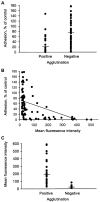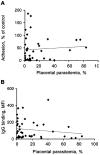Antibodies to variant surface antigens of Plasmodium falciparum-infected erythrocytes and adhesion inhibitory antibodies are associated with placental malaria and have overlapping and distinct targets
- PMID: 14745713
- PMCID: PMC2613478
- DOI: 10.1086/381186
Antibodies to variant surface antigens of Plasmodium falciparum-infected erythrocytes and adhesion inhibitory antibodies are associated with placental malaria and have overlapping and distinct targets
Erratum in
- J Infect Dis. 2004 Feb 15;189(4):759
Abstract
We measured antibodies to chondroitin sulfate A (CSA)-binding and placental Plasmodium falciparum-infected red blood cells (PRBCs) among pregnant women with or without placental malaria. Immunoglobulin G to PRBC surface antigens was rare in uninfected primigravidae (3.7%), more prevalent in infected primigravidae (70%; P<.001), and common in infected (77%) and uninfected (83%) multigravidae. Similar patterns were seen for agglutinating antibodies, and antibodies were similar among women with past or active placental infection. PRBC adhesion to CSA was inhibited 60% by serum from infected primigravidae but 24% by serum from uninfected primigravidae (P=.025), whereas infection did not alter adhesion inhibition by multigravidae (77% inhibition)[corrected]. There was substantial heterogeneity in antibody type and levels. Antibodies did not correlate with parasite density or pregnancy outcome. Comparisons between antibodies suggest that adhesion-inhibitory antibodies and those to PRBC variant antigens have distinct and overlapping epitopes, may be acquired independently, and have different roles in immunity.
Figures




References
-
- Rogerson SJ, van den Broek NR, Chaluluka E, Qonqwane C, Mhango CG, Molyneux ME. Malaria and anemia in antenatal women in Blantyre, Malawi: a twelve month survey. Am J Trop Med Hyg. 2000;62:335–40. - PubMed
-
- Steketee RW, Wirima JJ, Bloland PB, et al. Impairment of a pregnant woman’s acquired ability to limit Plasmodium falciparum by infection with human immunodeficiency virus type-1. Am J Trop Med Hyg. 1996;55:42–9. - PubMed
Publication types
MeSH terms
Substances
Grants and funding
LinkOut - more resources
Full Text Sources
Miscellaneous

